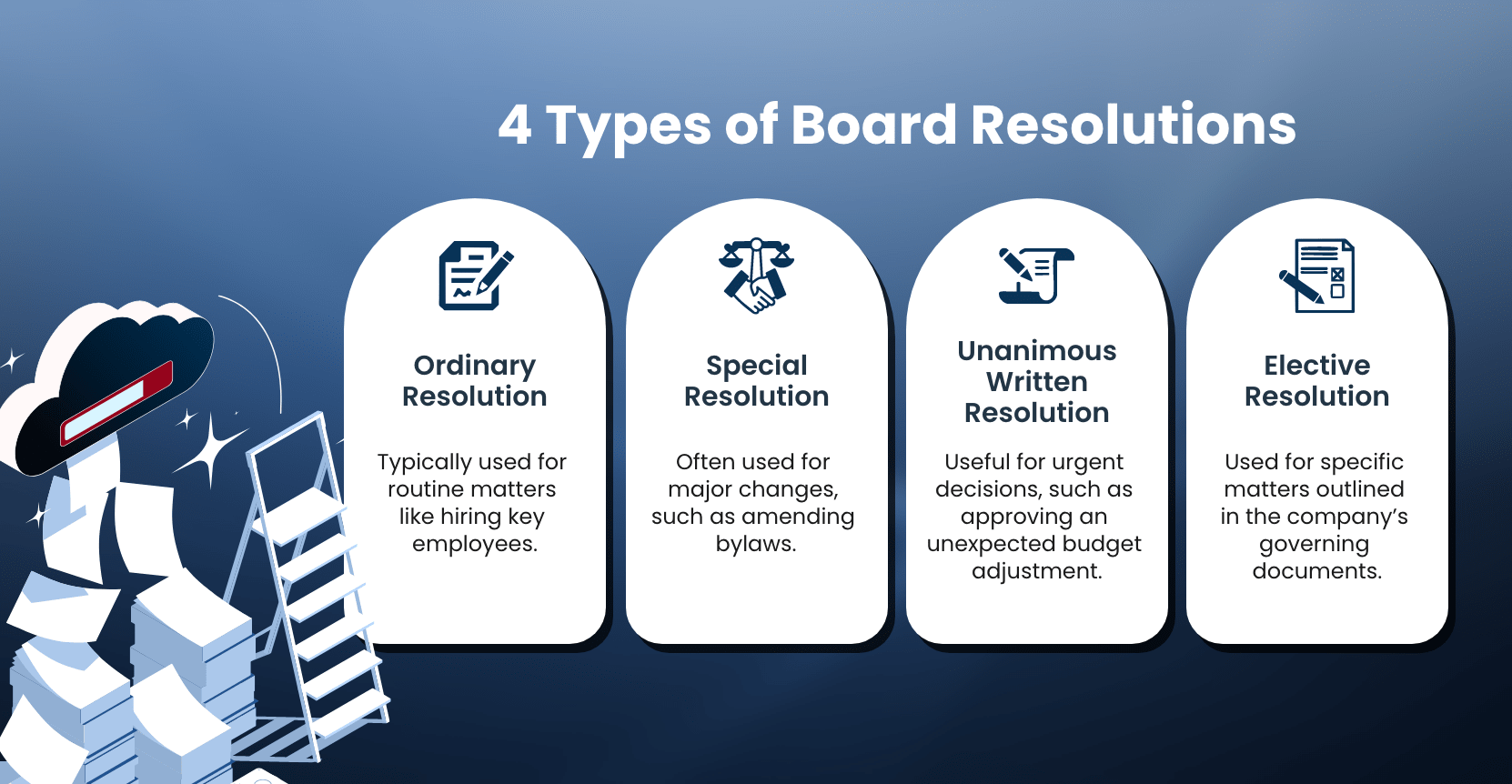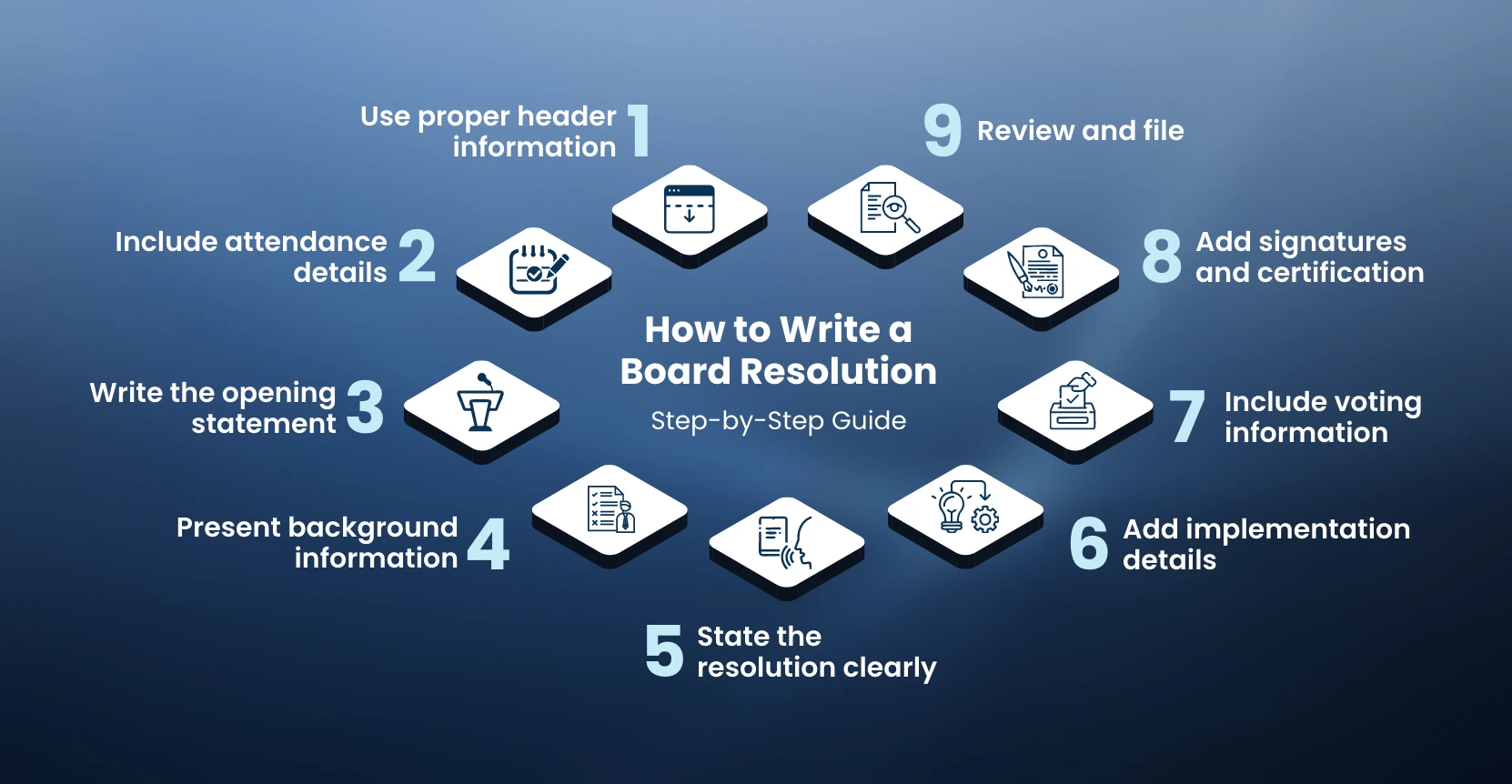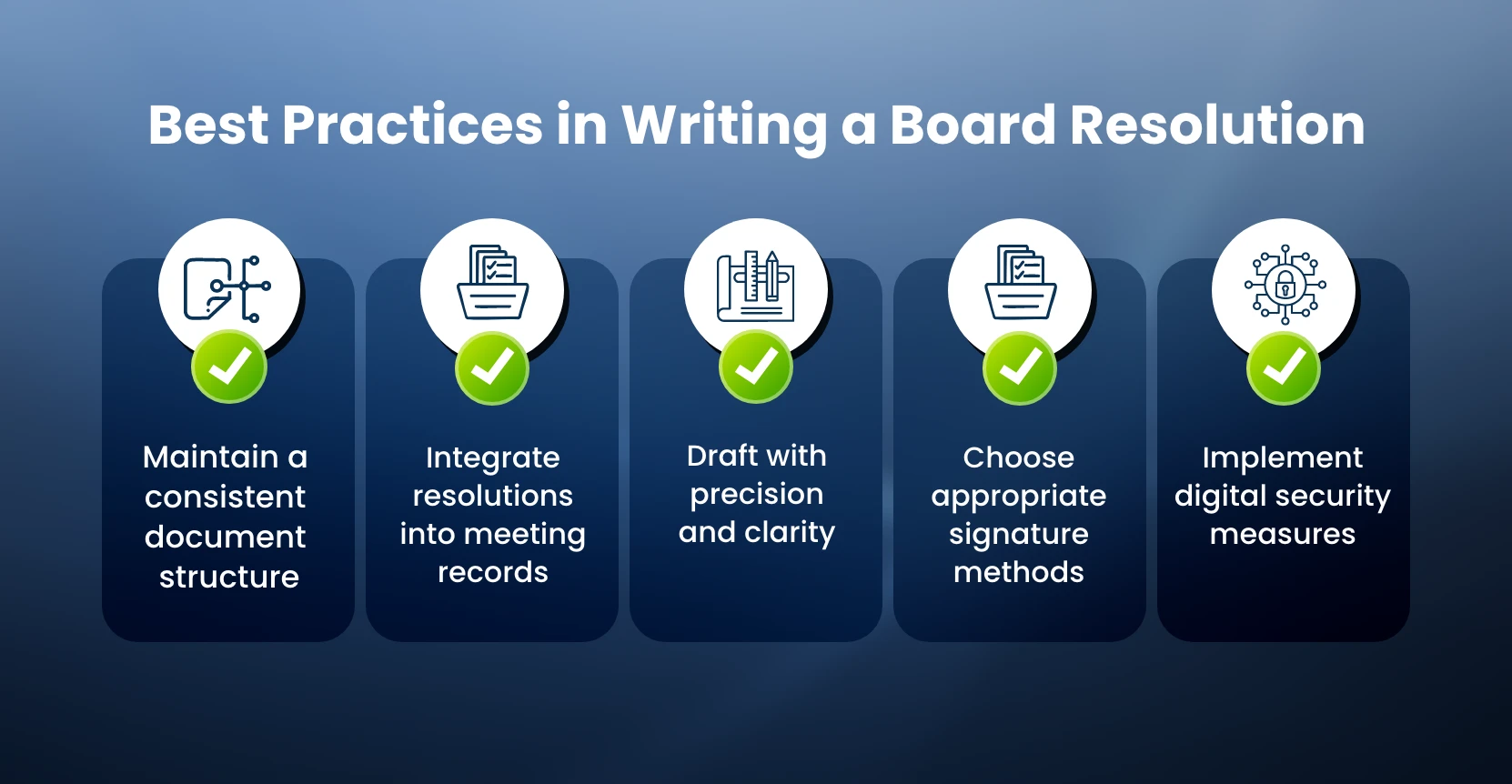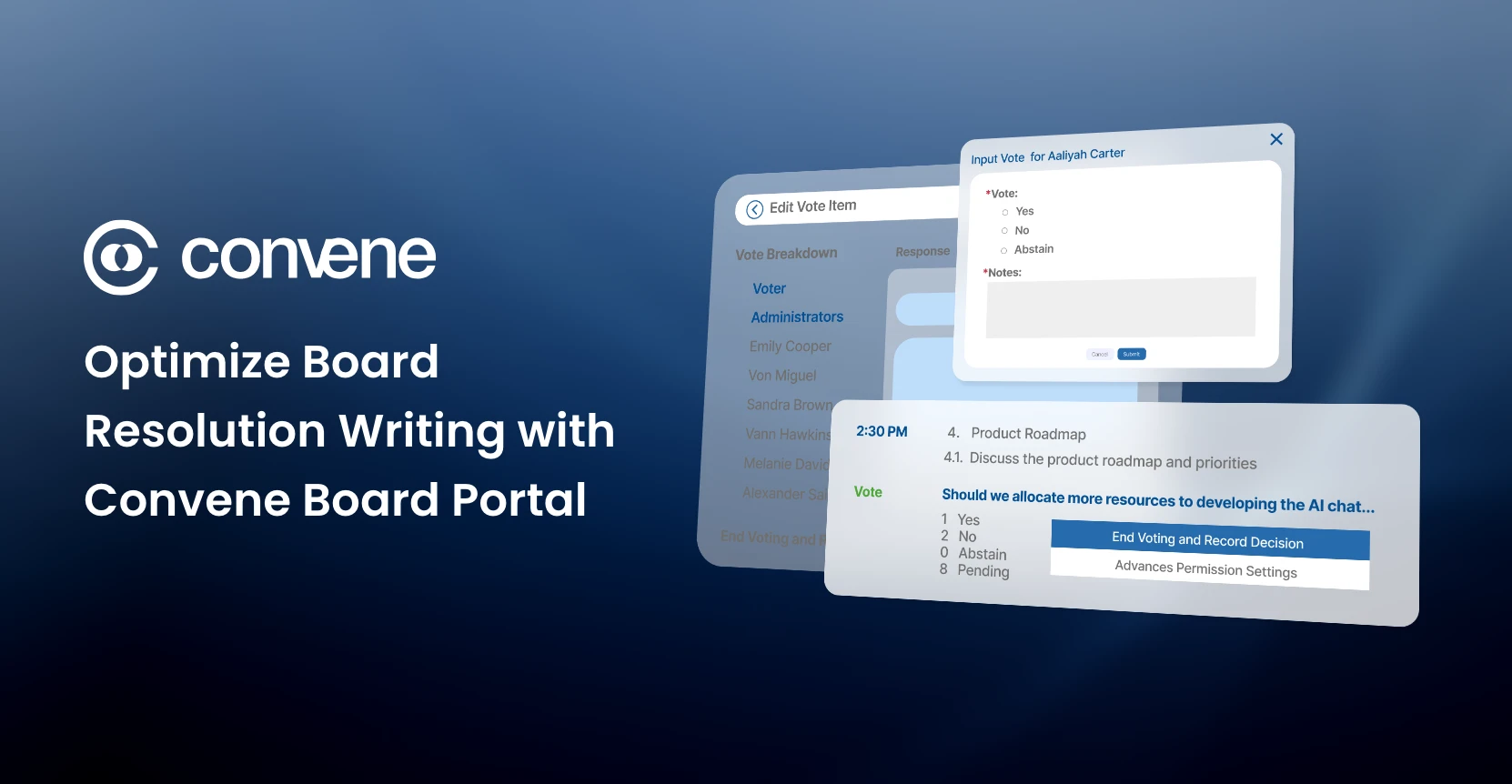The board is the primary decision-making body of an organization. Among their core responsibilities is resolving high-level company matters, including signing off on major initiatives, appointing key executives and committees, or authorizing financial transactions. However, given the high-stakes nature of these decisions, a verbal agreement is insufficient, which is why a formal record is necessary.
To ensure they carry legal and organizational weight, such actions must be formally documented through a board resolution passed by the members of the board.
So, what is a board resolution? This guide will let you in on everything you need to know about board resolutions, including the different types, benefits and risks, and how to write a resolution. You can also get access to a free downloadable template to help you get started. Plus, discover how a board portal can streamline resolution workflows through centralized access and real-time collaboration.
What is a board resolution?
A board resolution is a written document that records and formalizes decisions made by the board of directors during a board meeting. This usually includes the outcome of votes and the actions the board has unanimously agreed to take to address important business matters. The board resolution becomes part of the company’s official corporate records, acting as legal evidence that the board has fulfilled its governance responsibilities.
To be legally valid, a board resolution must be presented and certified during an official board meeting. This process involves verification by the board secretary (or an authorized officer) and is completed once the board chair signs the resolution. In rare cases, however, the board is allowed to sign the resolution without having to meet in person.
When is a board resolution required?
Board members can call a meeting at any time or for any reason to propose or vote on a resolution. Below are some instances when a resolution is required:
- Appointing or removing board members or executives, such as electing a new CEO.
- Approving company expansion, mergers, and acquisitions.
- Authorizing enterprise-wide financial decisions, including taking out large loans, approving major capital expenditures, or restructuring debt.
- Issuing, transferring, or selling company shares.
- Hiring or laying off a large number of employees, especially if the move affects multiple teams and departments.
- Creating, adopting, and approving new policies.
- Amending governing documents or corporate bylaws to adapt to changes in regulations or strategic plans.
- Entering or terminating key contracts, like vendor agreements or strategic partnerships.
Types of Board Resolutions
During board meetings, the board casts its votes to make collective decisions, which are then recorded in the board resolution. Each director usually has one vote. But depending on the given situation, the board may adopt different types of resolutions, such as:

Ordinary Resolution
The most common type of resolution, ordinary resolutions, requires a majority (more than 50%) of the directors present at the meeting to pass. It is typically used for routine matters such as hiring key employees or authorizing the sale of company shares.
Special Resolution
As the term implies, special resolutions are reserved for more significant decisions and usually require a supermajority vote, as defined in the company’s bylaws. These are often used for major changes such as amending bylaws or approving corporate restructuring.
Unanimous Written Resolution
Written resolutions, also called circulation resolutions, are formal corporate decisions made in writing. When directors cannot meet in person, they may all sign a unanimous written resolution outside of a formal meeting. This is especially useful for urgent decisions, such as approving an unexpected budget adjustment, that require full agreement without having to gather face-to-face.
Elective Resolution
Used for specific matters outlined in the company’s governing documents, such as decisions on share capital or stock buybacks. These are subject to rules defined in the bylaws or shareholders’ agreements.
What should be included in a board resolution?
Because of the formality of this document, board resolutions should be clear and well-written. It should include the following details:
- A clear and fitting title for the resolution
- The board meeting date
- The resolution number
- The resolution, including a preamble and the decision in question
- The names of the board of directors and their votes
- The chairperson’s or any relevant officer’s name, signature, and date signed
If necessary, include a certification section where the secretary confirms that the resolution was properly approved.
Access Free Board Resolution Template
Download our board resolution template for free to boost your board’s decision-making process.
How to Write a Board Resolution: Step-by-Step Guide
Writing a resolution requires careful attention to detail and proper formatting to ensure legal validity and clarity. To get you started, here’s an easy-to-follow nine-step guide to help you craft an effective board resolution from start to finish.

Step 1: Use proper header information
Always start with the basics. When drafting, do not forget to include the company name and legal entity type at the top of the document. Next, add the date and location of the board meeting (note if the meeting was conducted virtually). If your organization uses a numbering system for resolutions, assign an appropriate resolution number to maintain proper record-keeping.
Step 2: Include attendance details
Document board attendance—stating who was present and absent—to establish quorum and voting authority. To add, include the chairperson and any non-board attendees’ names, such as executives and legal counsel.
Step 3: Write the opening statement
Start your resolution with standard formal language that establishes the context and authority. Use phrases such as “WHEREAS, the Board of Directors of [Company Name] has met and deliberated on the following matter” to create a professional tone and indicate that the board has formally considered and agreed upon the issue at hand.
Step 4: Present background information
Use “WHEREAS” clauses to provide necessary context and justification for the resolution. Explain the situation or business need that prompted the resolution. For further support, reference any relevant documents, contracts, or prior board decisions that relate to the matter. It may also be helpful to include any legal requirements or regulatory considerations that influenced the decision. Gather all these and present the key facts in a logical sequence.
Step 5: State the resolution clearly
Write in clear, explicit language that leaves no room for misinterpretation. Be specific about the actions to be taken and include important details such as deadlines, monetary amounts, or other relevant parameters. It is also important to specify which individuals or positions are authorized to carry out the resolution. This document acts as legal proof for your organization, so it must be precise and definite.
Step 6: Add implementation details
Include practical elements that will guide the execution of the resolution. Designate the specific parties responsible for implementing the decision and set realistic timelines for completion. Specify any reporting requirements or checkpoints that will ensure proper oversight. Include any conditions, limitations, or approval processes that must be followed during implementation. Here is a sample clause:
“The Operations Team, with Finance and Compliance, shall implement this resolution within 90 days and submit biweekly reports; any changes require prior approval and must follow internal policies.”
Step 7: Include voting information
Document the decision-making process to create a complete log of the board’s actions. Record how each member voted on the resolution, or note if the decision was unanimous. Additionally, state the final vote count clearly and note if any members abstained from voting. This information is crucial for demonstrating that proper procedures were followed.
Step 8: Add signatures and certification
Complete the resolution with the necessary authentication elements. Once the writing process is done, the board secretary should sign and date the document to certify its accuracy. Apply the corporate seal if your organization uses one. Afterwards, include a certification statement that confirms the resolution was properly adopted according to the company’s bylaws and applicable regulations.
Step 9: Review and file
Before finalizing the resolution, conduct a thorough review to ensure accuracy, completeness, and legal compliance. File the completed resolution in your corporate records and distribute copies to all relevant parties who need to be informed of the decision or who will be involved in its implementation.
Best Practices in Writing a Board Resolution

The key to a well-crafted resolution is clarity and precision. Here are some best practices to follow when writing one.
Maintain a consistent document structure
If you have yet to do so, start by developing standardized formatting that creates predictable, professional documents. Uniform presentation helps stakeholders locate information quickly and reduces errors that occur when essential elements are inadvertently omitted from resolutions.
Integrate resolutions into meeting records
Make resolutions part of your permanent corporate record by incorporating them into official meeting minutes. Whether embedded directly or attached as appendices, this integration creates a complete decision trail that supports legal compliance and corporate transparency.
Draft with precision and clarity
Eliminate ambiguity by specifying exact actions, responsible parties, timelines, and conditions. This precision and clarity in writing prevent disputes during implementation and ensure everyone understands their obligations under the resolution.
Choose appropriate signature methods
Evaluate signature requirements based on the resolution’s purpose and applicable regulations. Digital signatures work for most corporate decisions, but specialized matters like financial authorizations may demand traditional wet signatures for full legal effect.
Implement digital security measures
Protect resolution documents through encrypted digital platforms like board portals or a repository that controls access and maintains backup systems. Proper technological safeguards prevent document loss while restricting viewing privileges to authorized personnel only.
Frequently Asked Questions on Board Resolutions
Can resolutions be approved outside of formal meetings?
Yes. If all board members agree, a resolution can be approved through written consent or a unanimous written resolution. This type is useful for urgent and unforeseen decisions, as it allows the board to act without convening a formal meeting.
What are the attendance requirements for meetings where resolutions are passed?
A quorum is usually required to hold a board meeting. This means a minimum number of directors must be present, physically or via remote attendance, to make official decisions. That said, having full participation leads to stronger, more balanced decision-making.
Do all board members need to sign each resolution?
Not always. A board member’s primary role in this process is to participate in discussions and cast their vote on key matters. The board secretary will then record the outcome in the official meeting minutes and have the board chair sign. However, for major corporate moves, like mergers or high-value contracts, individual signatures or written consent from each director may be required.
Optimize Board Resolution Writing with Convene
As the responsible authority for the organization’s decision-making, writing board resolutions is one of the essential responsibilities a board member must be familiar with. But with packed schedules, time-sensitive decisions, and increasing governance demands, creating resolutions can often feel overwhelming.
A leading board meeting and management software, Convene makes this process easier by providing a simple and secure platform that helps boards finalize and approve resolutions efficiently, minimizing administrative burdens and enabling more informed decisions.

With Convene, you can:
- Make meetings more streamlined and engaging, thanks to the platform’s embedded live video conferencing and interactive tools that facilitate productive remote sessions.
- Take advantage of a secure and centralized document repository that ensures all board materials, including draft resolutions, supporting documents, and signed copies, are stored in one accessible location, keeping everything organized and compliant.
- Allow board members to expedite decision-making by instantly casting votes during meetings, through features like in-meeting voting and resolution tracking.
- Act on important matters through resolutions and sign and approve documents electronically.
- Automate routine tasks, streamline access to files across platforms, and strengthen governance controls with the help of new features like Convene AI, Google Drive integration, and Convene Authority.
Get this and more when you switch to Convene. Schedule a live demo today to get a one-on-one consultation with our product experts.
Audrey is a Content Marketing Specialist at Convene, in charge of managing the production of quality content on the company’s website. A communication major keen on marketing, Audrey has been constantly seeking approaches to create tailored content—may it be about governance, digitalization, boards, or meetings—fit for the stakeholders. When not strategizing on the next ebook to produce, Audrey finds solitude in reading make-you-ugly-cry novels and listening to self-improvement podcasts.











